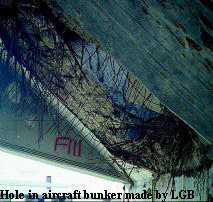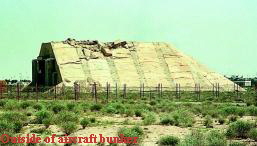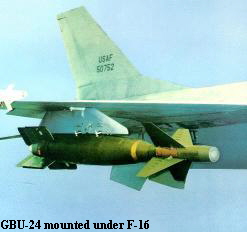|
"It works as advertised." -- Capt. Don Godier, F-16 pilot. T
hat kill record included the Than Hoa Bridge. After many tries, the Than Hoa was dropped for good during the war on May 13, 1972. Also during the
Linebacker raids, it was the Paveway bombs which brought about dropping a span of the equally vexing Paul Doumier bridge -- the despised Hanoi target of many Air Force and Navy aircrews -- and putting that bridge out of
commission for the rest of the war. Paveway became the star of the Linebacker bombing campaigns. Air Force leaders altered their tactics, sending fewer fighter bombers up North because of the accuracy of the bombs
meant they only had to rely on the laser guided bomb equipped fighters. The raids, which were designed to bring North Vietnam back to the Paris peace talks, were the first to use precision guided munitions like
the laser guided bombs in integrated bombing tactics.
Yet two decades wou ld pass, before the laser guided bombs became
the focus of global attention during another, more popular conflict, the Gulf War. As accurate and well publicized as the Paveway bombs were, it was the use of laser guided bombs and other
precision guided munitions in late 1995 during Operation Deliberate Force over Bosnia which made them an instrument of foreign policy. The bombs were used with precision to surgically remove
artillery emplacements, ammunition storage areas and command posts from troops which had killed and brought suffering to the people of the former Yugoslavia. ld pass, before the laser guided bombs became
the focus of global attention during another, more popular conflict, the Gulf War. As accurate and well publicized as the Paveway bombs were, it was the use of laser guided bombs and other
precision guided munitions in late 1995 during Operation Deliberate Force over Bosnia which made them an instrument of foreign policy. The bombs were used with precision to surgically remove
artillery emplacements, ammunition storage areas and command posts from troops which had killed and brought suffering to the people of the former Yugoslavia.
A burst of flak or shoulder launched surface to air missile can cripple or destroy an aircraft and force a pilot to eject and face death or
capture. A misplaced bomb can bring tragedy to the people military air forces are trying to protect. To U.S. Air Force Captains Brick Izzi and
Don Godier, who both flew strikes with the 555th Fighter Squadron during Deliberate Force, there are few other proven ways in limited combat to limit needless civilian and friendly deaths than to use laser
guided bombs. The pilots, both weapons officers, flew several
Bosnia strikes using laser guided bombs, in 1995.
"It works as advertised. One of the great things about this weapon
overall is that I can go and find the target at range I can stay at a high enough altitude, avoid most of the threats and then go ahead and deliver my bomb. Then watch my bomb impact, leave the target, get (a B omb Damage Assessment through the pod) and then go home and tell
them that no kidding that building is gone," said Godier, who now flies with the 68th Fighter Squadron at Moody Air Force Base, Georgia. omb Damage Assessment through the pod) and then go home and tell
them that no kidding that building is gone," said Godier, who now flies with the 68th Fighter Squadron at Moody Air Force Base, Georgia.
The pods spot the laser on the
target, and it makes a record of the damage. This keeps from sending pilots back on needless missions to verify targets are destroyed. "It's a feedback loop for the
commanders and decision makers. That keeps the lift going so you don't have to send guys back to i.e. 'recce' the target. Or send our guys
back to destroy something that is already gone," said Izzi, who flies with the 68th's sister squadron at Moody, the 69th Fighter Squadron.
The pilots said the weapons were so accurate they were used less than a mile from civilian structures such as hospitals and apartment complexes which went virtually undamaged, and no loss of civilian life
was reported to the pilots due to the strikes, they said.
"In Bosnia, the real threat was collateral damage. You didn't want to
drop bombs on the wrong people. So, we would hang out in the target area as long as we could to make sure our bombs hit the right place." Izzi said.
"We had the right weapons to do that," Godier remembered.
Many times during the three week long Bosnia strikes, Godier saw a
"frag" or a fragment of an attack order which would direct pilots against targets that were no longer there. He or another pilot would bring out the tapes and prove the target no longer existed.
The NATO aircraft released 1,026 munitions, of which 708 were precision guided weapons. The raids were very successful and helped
to bring the Serbs and Croats to the peace table. Some three decades after finding that initial $100,000 to develop the laser guided bomb, Word and his TI team had accomplished the goal of not only increasing
accuracy of bombs, but also of removing aircrews from danger.
Even though the small Texas company which was hardly manufacturing semi conductors when Word helped to build the laser
guided bomb has merged with Raytheon, within the Texas Instruments of today the legacy of guided weapons is one to live up to, said Ben Ford who currently manages the Pav eway program for TI. eway program for TI.
"You're kind of brought up on
some of these legends in Texas Instruments, especially if you were involved in the Paveway programs," Ford said. "Word and the people that put that first system together were very bright, capable people. It
wouldn't have happened if not for them. We owe the whole program to their early work."
The engineer who pushed laser guidance -- Dave Salonimer -- died in the early 1990s. However, today,
Word, Baker and Weaver are all retired, preferring the simple life to the bustle of engineering weapons systems and spending his time on airplanes headed to Washington, D.C. Word believes that even though a
bomb is still a weapon of war, the laser guided concept helped save lives during Vietnam.
"This kind of puts it in perspective for me. The people on the Air
Staff, when Vietnam was over told us that there was probably 100,000 body bags that didn't come home because of Paveway. Whether that's true or not, I don't know, but that sort of puts it in a term that puts
goose bumps on the back of your neck," Word said. |
|